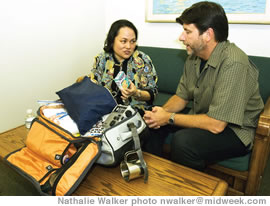Preparing For The Next Pandemic
Don’t panic, but Dr. Chiyome Fukino wants everyone to have an emergency kit
By Alice Keesing
E-mail this story | Print this page | Archive | RSS |
 Del.icio.us
Del.icio.us
Dr. Fukino with Dr. Morgan Barrett and her emergency
pack
a principal?” When she considered becoming a secretary, he said, “Well, why not be a lawyer?” When she was thinking about being a nurse, her dad said, “Well, why not be a doctor?”
One day, one of her dad’s clients told him about a scholarship to encourage more women and native Hawaiians to enter medicine. And so Fukino ended up becoming a doctor. After earning her psychology degree at Brandeis University, she graduated from the UH John Burns medical school.
Fukino worked in private practice and, among other leadership roles, was medical director of the Queen’s Physician Group. Throughout her career she has been deeply passionate about improving native Hawaiians’ health and exploring the role of ancient Hawaiian healing practices in the modern medical arena.
When she was asked to put her name forward for the position of health director, she laughingly asked a friend, “What, do you see the word ‘stupid’ tattooed across my forehead?”
Now, as she sits in the director’s Punchbowl Street office, she laughs even more. “Well,” she says, “apparently it was.”
In 2002, Gov. Linda Lingle appointed Fukino to the job, making her the first female director of the department and, it’s believed, the first native Hawaiian to hold the post. What she took on is a department with a nearly $1 billion budget and almost 4,000 employees who look after everything from solid waste to mental health to smoking cessation. And her leadership has been well-received by the medical community.
“Having Dr. Fukino in this role at this time - this post-Katrina-possible-pandemic-terrorist era - she’s the right person for the job,” Clairmont says.
Fukino is clearly not a political person. She is refreshingly candid. She is soft-spoken and funny at the same time. She dresses in comfy clothes and athletic shoes, although she did visit makeup artist Stephen Kalama before her cover shoot. And after four years in the bureaucracy her genuine motivation is to do her best for the people of Hawaii. Which perhaps explains her drive to prepare for pandemic flu because she thinks of how individual people will be affected, not just the businesses and state operations.
How will parents be able to keep working if the schools are closed? she asks. How will people pay their mortgages if the banks are closed? How will elderly people who rely on Meals on Wheels survive if a quarantine is enforced?
Weathering a pandemic will require us to look after ourselves and look after each other, she says.
“In some ways we need to be moving back to the 1940s and 1950s where you know your neighbors and you care for each other,” she says. “We need to gain the benefits of that time, those human touch things.”
The health department has been very busy in recent times. It is stockpiling anti-viral medication. It is screening sick passengers who arrive at Honolulu International Airport. It has increased laboratory capacity. It is talking with business about how they can keep things running when 30 percent of their work force is down. It has thought long and hard about the quarantine provision that allows the department to segregate those people who have been exposed to the deadly virus. It is creating and training a volunteer medical corps that will be called on to respond to the outbreak.
And now, it’s your turn.
In recent weeks the department has started letting people know what they can do to prepare. There is information on the radio and television. There is more on the health department’s website at www.hawaii.gov/health. And you received an emergency planning workbook in your MidWeek two weeks ago that contains checklists and tips for families. (If you can’t find your copy, call Aloha United Way at 2-1-1, and one will be sent to you.)
Some of the preparation is simple. You can brush up on your hygiene etiquette. Wash your hands often and well. Forgo the local kiss-on-the-cheek greeting. Sneeze and cough into a tissue or into the crook of your elbow - but not into your hands.
Officials may ask you to physically distance yourself from others or even stay home to help stop the virus from spreading. To get through that time, be sure you have a stockpile of supplies that you can live on for at least two weeks, Fukino recommends. And don’t forget to pack yourself (and all your family members) one of those emergency survival kits like the one Fukino keeps in her office.
Only 20 percent of Americans say they are prepared for an emergency, according to the Red Cross. And it’s not good enough to think you can do it once you know for sure that something is on its way, Clairmont warns.
“By the time the first case is spotted, it will be too late,” he says.
So, are you ready?
Page 2 of 2 pages for this story < 1 2
E-mail this story | Print this page | Comments (0) | Archive | RSS
Most Recent Comment(s):








